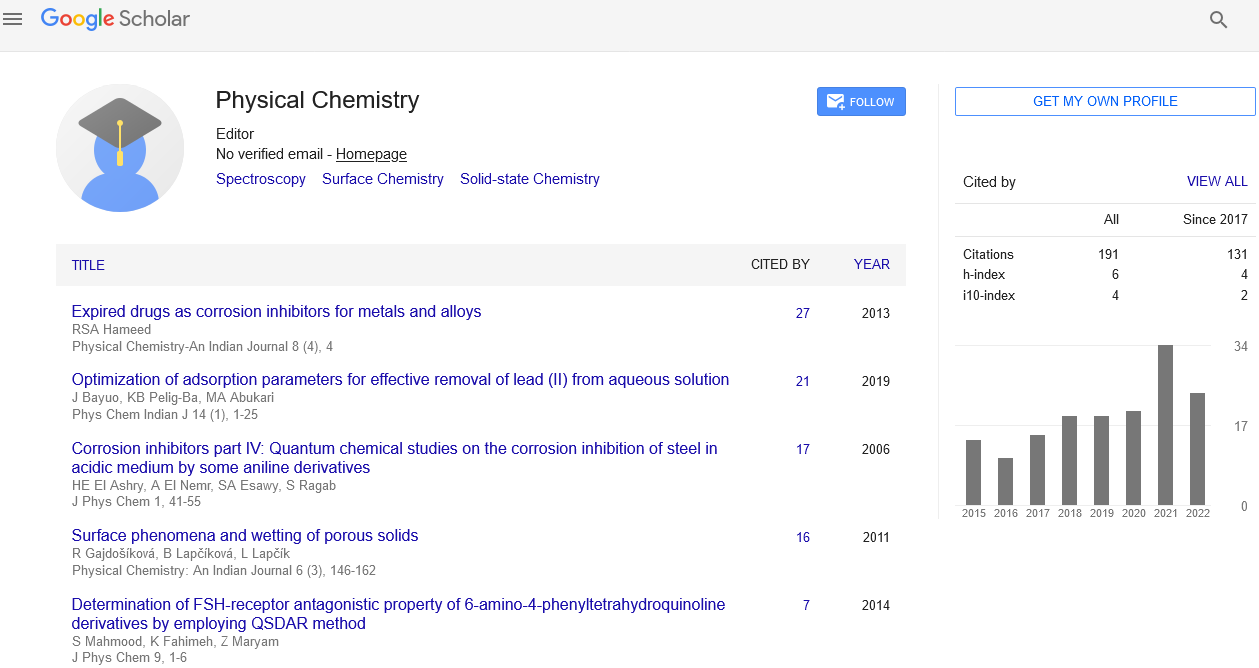Current opinion
, Volume: 16( 6)Polytypism in Lead Halide Perovskites: An Evolutionary Investigation
Joseph Millan *
- *Correspondence:
- Joseph Millan
Editorial Office,
Physcal Chemstry: An Indian Journal,
United Kingdom,
E-mail: physicalchem@journalres.com
Received: November 11, 2021; Accepted: November 15, 2021; Published: November 30, 2021
Citation: Millan J. Polytypism in Lead Halide Perovskites: An Evolutonary Investigation. Phys Chem Ind J. 2021;16(6):158
Abstract
Close-packed AX3 layers piled along the h111i axis make up the standard ABX3 cubic perovskite structure. In addition to a succession of intermediate polytype sequences, an equivalent hexagonal close-packed network can be created. Internally, there are combinations of face- and cornersharing octahedral chains that can drastically affect the material's physical properties. The thermodynamics of polytypism in CsPbI3 and CsPbBr3 are investigated here. Density functional theory total energies are utilised to paramaterize an axial Ising-type model Hamiltonian with linear and cubic correlation terms of the pseudo-spin. The polytype phase space, which expands exponentially with the number of layers, is explored using a genetic algorithm. The ground-state structures of CsPbX3 polytypes are investigated in order to identify polytypism traits such as unique layer configurations and symmetry prohibited sequences.
Introduction
In solid-state chemistry and physics, perovskite is an important and adaptable structural type. Since the first publication of a photoactive absorber in 20095, metal halide perovskites have gained significant attention as photovoltaic materials, with the power conversion efficiency (PCE) growing from 3.8 percent to the current record of 25.5 percent. 6 Synthesizing large-area single-crystal perovskite lms, which is challenging due to intense phase competition, is one key to improving solar cell technologies based on hybrid organic–inorganic perovskites such as MAPbI3 (MA 14 CH3NH3 + ) and FAPbI3 (FA 14 CH(NH2)2 + ) or inorganic lead halide perovskites such as CsPbBr3 and CsPbI. At temperatures as low as 80 C,7 MAPbI3 degrades, releasing CH3I and NH3 gas, creating a long-term stability problem. The compositions utilised in cutting-edge perovskite solar cells are shiing to include FA+ and Cs+ as A-site cations, with reported PCEs of up to 25.2 percent 8 and 20.4 percent 9, respectively.
In situ optical microspectroscopy confirmed the presence of cubic and hexagonal domains in a FAPbI3 nanowire, indicating that phases can coexist in as-synthesized perovskite crystals. 15 At the phase boundary, the authors postulated a disordered amorphous interfacial layer with deformed and slanted octahedra. The mixed perovskite MA1xFAxPbI3 (x 14 0.5, 1) was recently reported as well, with characterization indicating the existence of an intergrain 2H phase. Polytype engineering, as demonstrated for hexagonal oxide perovskites in a variety of energy-related applications, can offer unique electrical and ion transport features. Polytypism in lead halide perovskites has also been demonstrated to be energetically accessible. At 0 K, first-principles calculations found that the formation enthalpy of d-FAPbI3 was 70 meV per formula unit lower than that of aFAPbI3. The formation enthalpy of a hexagonal CsPbBr3/CsPbI3 phase is 40 meV/90 meV per formula unit higher/lower than the corresponding cubic phases at 0 K, according to our density functional theory (DFT) calculations.
Computational Methods
In this work, we used a variety of computer simulation methods. DFT can offer rst-principles total energies that are reliable, but it is confined to tiny polytype stacking sequences. As a result, to quickly forecast polytype energies and quantify the level of polytype disorder, a model Hamiltonian technique was used.
Training data- DFT calculations were done for each polytype in the training set using the Vienna Ab initio Simulation Package (VASP) and the conventional frozen-core projector augmentedwave (PAW) technique. For basis functions, the cutoff energy was 420 eV. The exchange-correlation was calculated using the generalised gradient approximation (GGA) of the Perdew–Burke–Ernzerhof functional for solids (PBEsol).
Model construction- The summation of each correlation function, Pisi, Pisisi+1, and so on, was numerically calculated to get the interaction coefficients for the model Hamiltonian. The related interaction coefficients, J0, J1, and so on, were obtained by solving the linear matrix to provide least-squares solutions.
Genetic algorithm- A genetic algorithm was created with the model Hamiltonian as the objective function to quickly determine the ground-state stacking sequences for a given layer number. The maximum number of iterations, population size, mutation probability, elite ratio, crossover probability, and parental portion are all parameters to consider when executing this algorithm. These settings can be tweaked to keep track of and improve the algorithm's performance. In the results section, you'll find the converged values.
Results
The ordering energy of a CsPbX3 polytype can be used to determine its thermodynamic stability. Two neighbouring PbX6- octahedra are joined either with a face-sharing (h) or a corner-sharing (c) configuration throughout the stacking chain of a polytype, generating a unique stacking sequence for each polytype, which dictates the interaction between layers and its formability. The Madelung energy based on point charges should properly characterise phase energetics for an ionic crystal. However, due to the influence of ion polarisation, we discovered that CsPbX3 is outside of this regime. The Madelung energies of all polytypes for the two halide perovskites CsPbBr3 and CsPbI3 were computed under the ideal ionic lattice assumption, and we discovered that cubic 3C should be the most stable phase. Furthermore, the non-negligible function of anion polarisation in CsPbI3 and CsPbBr3 polytypes suggests the importance of anion polarisation; yet, Pb2+ is also highly polarisable due to its lone pair (6s2) electrons, which adds to the ionic dielectric response.
Conclusion
Sequences of the face- and corner-sharing PbX6 octahedra can be used to depict a family of perovskite polytypes. Exhaustive rst-principles calculations are resource and time intensive due to the combinatorial explosion caused by the increasing periodicity of the stacking sequence. An Ising-type model Hamiltonian was created to solve this difficulty, and the total energy for every given stacking sequence can now be quickly determined. The ground state structures for a N layer polytype hncm were then discovered using a genetic algorithm. Without enumerating the sequences, the technique can converge to the lowest energy sequence in seconds. We discovered symmetry prohibited sequences as a result of plateaus in the convergence behaviour, which reduces the number of possible valid configurations of h and c to construct polytype structures.

